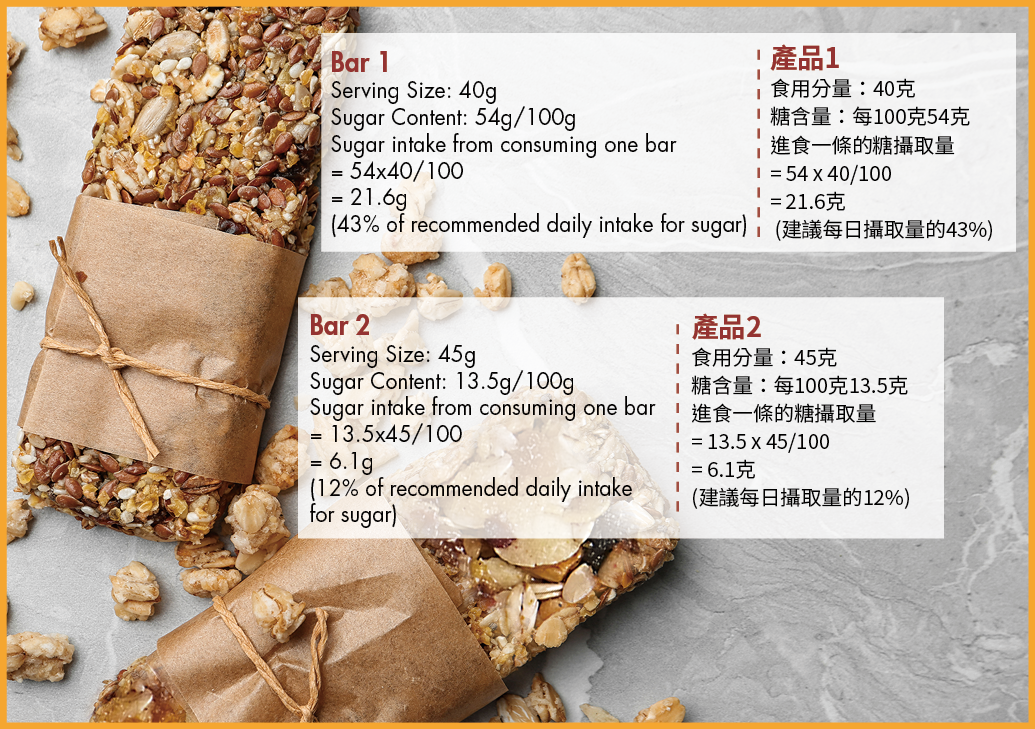
Food Safety Focus (167th Issue, June 2020) – Food Safety Platform
Avoid High Sugar Traps in Snacks
Reported by Dr. Anna SP TANG, Scientific Officer,
Risk Communication Section, Centre for Food Safety
Upon the recent COVID-19 pandemic, practising social distancing may mean staying at home for some, keeping physically active for others while reducing social contacts. At times one may be tempted to reach out for foods to snack on, or want to get a quick energy boost. Marketed as “energy bar” or “snack bar”, some pre-packaged food products may be perceived as being a healthier option by some, but are actually high in sugar content (>15g sugars/100g) as reported in a local study. This article explores how we may choose these products wisely to avoid “sugar traps” and maintain a healthy diet.

Figure 1: Sugar contents in the various products on the market vary widely. Bar 1 with a higher sugar content: consuming one bar reaches almost half of the recommended daily intake for sugar; Bar 2 with a lower sugar content: consuming one bar reaches about 12% of the recommended daily intake.
Energy Bars – Health or Hype?
Pre-packaged products are popular for some for their convenience in a fast-paced, on-the-run society. Many types of pocket-sized bars emerge on the market under various names such as “nutrition bar”, “energy bar”, “protein bar”, “meal replacement bar”, “breakfast cereal bars” and “diet bar”, containing ingredients like grains, nuts, dried fruits, protein or plant protein. Savvy marketing creates an impression that these food products are a healthy and nutritious choice as an alternative to a meal or for energy refill after exercise. Many of them, however, leave a lot to be desired in the nutrition department.
Like any food, energy bars consist of macronutrients such as protein, carbohydrates and fat, as well as micronutrients like vitamins, minerals and essential fatty acids. Of note, many bars are high in carbohydrates, ranging anywhere from 10 to 50 grams in a bar, depending on the brand and intended use. They may include complex carbohydrates (i.e. polysaccharides) like starch and dietary fibre, such as in oats or rice, and simple carbohydrates (i.e. monosaccharides and disaccharides) such as sucrose, glucose and fructose. Sugar and sweeteners such as polydextrose and sorbitol, as well as food additives such as maltodextrin, are often added into the bars during processing in order to improve texture and sweetness levels to satisfy consumers’ palates. While these products claim to help keep blood sugar levels at a moderate level for athletes, some energy bars produce a quick rush of blood sugar followed by a rapid decline, which is not much different than what occurs with a candy bar or bread.
Digesting the Bar Facts: Read the Nutrition Labels
Sugars are simple carbohydrates (monosaccharides and disaccharides) which provide energy (1g of sugars provides 4 Kcal). Excess calories from foods high in free sugars can contribute to unhealthy weight gain and obesity, increasing the risk of diabetes and other non-communicable diseases. Free sugars mean all mono- and di-saccharides added to foods by the manufacturer, cook or consumer, plus sugars naturally present in honey, syrup and fruit juices in diets. The World Health Organization sets out guidelines which recommend the public to reduce free sugars intake to less than 10% of total energy intake for both adults and children, i.e. less than 50 grams of free sugars (about 10 sugar cubes) per day for an adult having a daily 2000-Kcal diet.
Consumers may be confused sorting through all the heavily hyped promotional statements on the front package of the bars. Striving not to exceed the daily recommended free sugars intake, consumers are advised to read the list of ingredients and compare products. Reading nutrition labels allows better understanding of the sugar contents and calories when choosing these products to suit the individual’s need and activity level, and for weight-watching.
After exercise, carbohydrates, protein and water are to be replenished. There are many fresh food alternatives that readily meet these needs. Portable fruits such as apples and bananas are just as convenient, provide quick energy and are healthier options. It is always better to grab a quick yet healthy meal with adequate portions of fresh vegetables, fruits and grains. When choosing snacks, consider healthy options such as fresh fruits and tomatoes, bearing in mind that calorie-dense energy bars are not the suitable choice for snacking.


